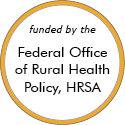Rural Project Examples: Healthcare facilities
Other Project Examples
Jefferson Healthcare Prescription CSA
Added July 2023
- Need: To increase food security among low-income patients living with cancer and diabetes in rural Jefferson County, Washington.
- Intervention: A local healthcare system partnered with a small organic farm to offer weekly produce boxes to eligible low-income patients.
- Results: 10 patients participated in the Jefferson Healthcare prescription CSA program in 2022. In 2023, the program grew to serve 15 patients.
The Minnesota Integrative Behavioral Health Program
Updated/reviewed May 2023
- Need: Out of 79 Critical Access Hospitals (CAHs) surveyed in Minnesota in 2015, behavioral health was the most frequently cited service requested.
- Intervention: In response, Rural Health Innovations launched the Minnesota Integrative Behavioral Health Program. This initiative engaged representatives across all sectors in health integration between hospital, primary care, and community services.
- Results: Strategy sessions resulted in the creation of resource directories to improve care coordination, evaluation measurements to document results, and an overall better understanding of integrative care challenges.
Addiction Recovery Mobile Outreach Team (ARMOT)

Updated/reviewed January 2023
- Need: To reduce the number of overdoses and overdose-related deaths from opioids in rural Pennsylvania.
- Intervention: ARMOT provides 1) case management and recovery support services to individuals with substance use disorders and 2) education and support to rural hospital staff, patients, and their loved ones.
- Results: Since 2015, ARMOT has received over 2,956 referrals.
FORWARD NM Pathways to Health Careers

Updated/reviewed November 2022
- Need: New Mexico's southwestern counties of Hidalgo, Catron, Luna, and Grant have experienced chronic shortages of primary care providers. New Mexico has the oldest physician population in the country.
- Intervention: A comprehensive workforce pipeline program, including programming for middle and high school students, undergraduate and graduate students, primary care program students, and medical and dental residents.
- Results: The program reaches over 1,000 school-aged students throughout the service areas and provides support for students and medical residents in a variety of healthcare-related programs for rural rotation experiences. FORWARD NM received its designation as an Area Health Education Center (AHEC) in 2012.
Maine Critical Access Integrated Paramedics

Added August 2022
- Need: With the nearest hospital more than an hour away, the local community health center in rural Jackman, Maine struggled to maintain its ability to offer 24/7 care to due to staffing and budgetary challenges.
- Intervention: Critical Access Integrated Paramedics provide urgent care to patients after hours and on weekends.
- Results: The Jackman Community Health Center has been able to offer round-the-clock care to clinic patients, while also increasing the level of EMS service available to the community.
Boone County Health Center Pulmonary Rehabilitation Program
Updated/reviewed June 2022
- Need: Evidenced-based intervention to improve function and quality of life for patients with chronic obstructive pulmonary disease and other chronic lower respiratory conditions.
- Intervention: Pulmonary rehabilitation program implementation in 1989.
- Results: Compared to a national average of only about 3% of referred Medicare beneficiaries actually enrolling in pulmonary rehabilitation, 60% of the program's referred patients enroll. Averaging around 15 patients/year completing the program, a large combined cardiac and pulmonary rehabilitation maintenance population averages 8,000 visits/year.
Futures Without Violence in Tillamook County

Updated/reviewed August 2021
- Need: To address intimate partner violence (IPV) in primary care settings as a health concern. To increase healthcare providers' professional understanding about its prevalence and adverse impacts on patient health.
- Intervention: In partnership with Safer Futures, Tides of Change provides an advocate at a local health clinic to give confidential services to IPV survivors and training to medical staff. The advocate uses curriculum and other materials designed by Futures Without Violence.
- Results: Healthcare providers at the clinic reported increased understanding of IPV and its impact on health. As a result, IPV advocates received an increase in referrals from healthcare providers. Patients experiencing IPV reported a reduction in chronic, toxic stress and improved overall health after receiving advocacy services.
Avita Health System Comprehensive Cardiology Program
Added April 2021
- Need: Population health approach to decreasing area deaths from cardiovascular disease.
- Intervention: A health system-level investment in level II cardiac catheterization services and the required specialized cardiology workforce.
- Results: Since August 2018, the Avita Health System in north central Ohio has provided local cardiovascular services that have decreased hospital transfers, increased care coordination, and provided education and prevention activities that, with time, will impact population health cardiovascular outcomes.
Southwest Health System Antibiotic Stewardship Program
Updated/reviewed March 2021
- Need: Impact patient care and safety issues related to antibiotic use in southwest Colorado.
- Intervention: Pharmacy-led antibiotic stewardship program for inpatient, outpatient, and long-term care settings.
- Results: With antibiotic use guidelines, refined infection diagnostics, and first-choice antibiotic selections, all care settings now see decreased days of treatment and decreased resistance patterns.
For examples from other sources, see:
